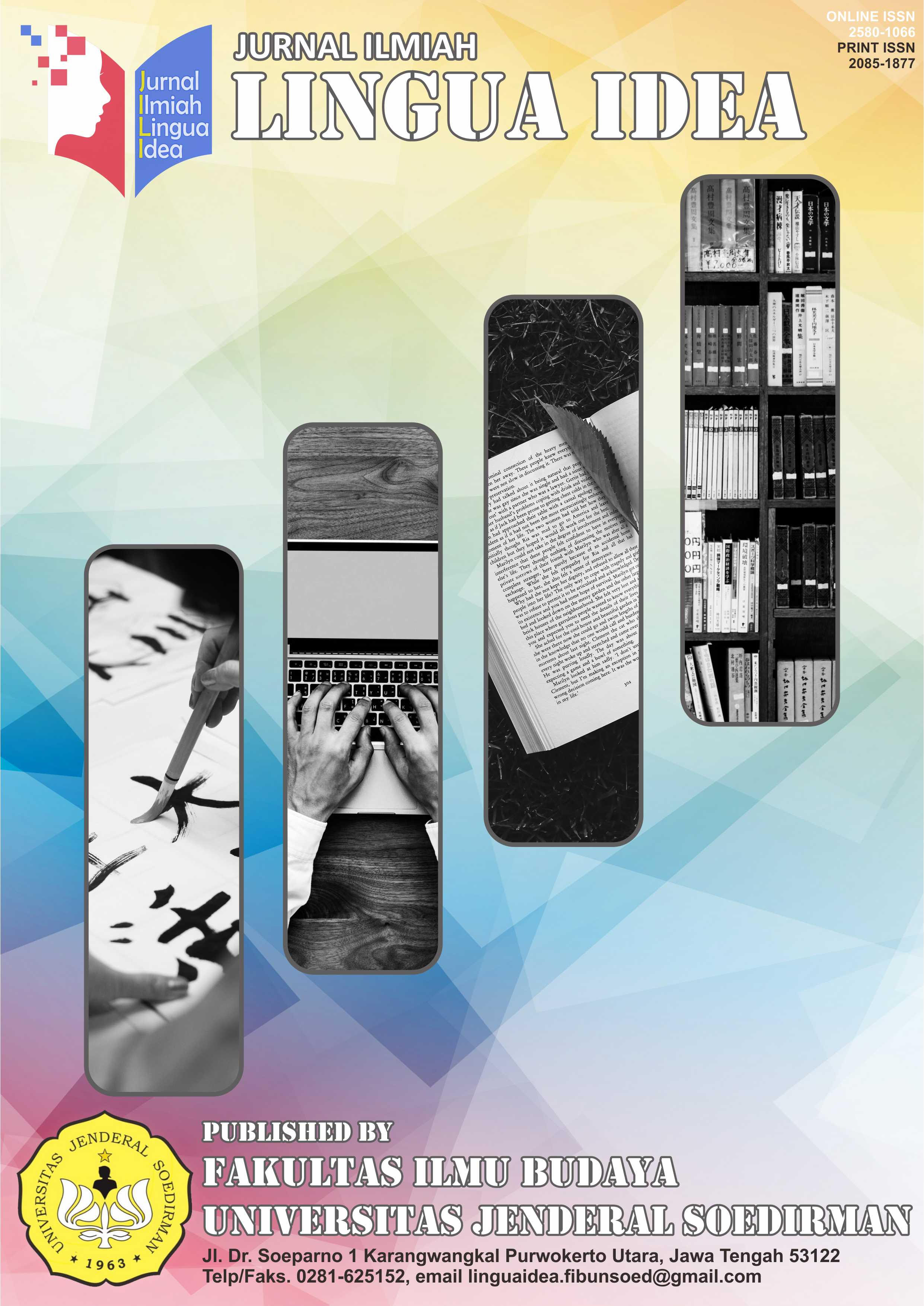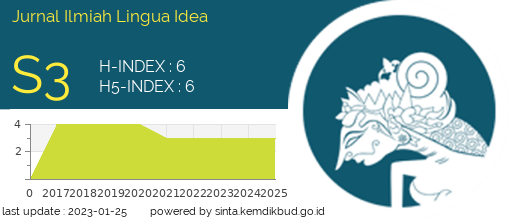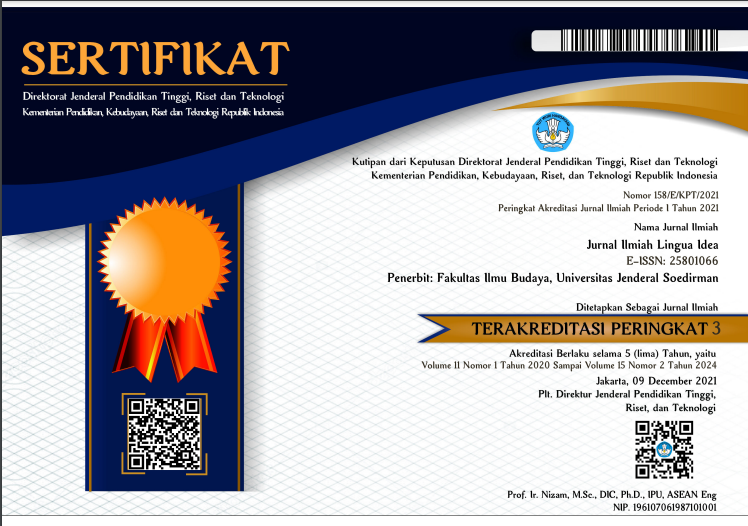The Use of Cohesive Devices and Factors Influence Unsuccessful Coherence in Community-Based Tourism Text
Abstract
As a complex process, writing is always interesting to be discussed. One of the students' biggest problems in writing is in maintaining coherence. Coherence is a systemic model to unify some elements to become good writing. This article aims to identify the most cohesion type used by the students and factors that influence the unsuccessful coherence of the text. This is a descriptive qualitative research. The data were obtained by collecting descriptive text written by thirteen English Diploma Program students. The unit of analysis in this study is a community –based tourism text which describes tourism villages in Banyumas Regency, Indonesia. The writers take Community-Based Tourism (CBT) as the unit of analysis because the government right now is developing CBT in many areas in Indonesia. As an important stakeholder, the University must prepare the students to write good descriptions of CBT. The result of this study shows most of the students use reference, reiteration, and conjunction in their writing but they have very minimal use of ellipsis, substitution, and collocation. The writers found that some of the students' sentences have successful integration, but some have not successful integration. There are several factors influence unsuccessful integration. Those are students' prior knowledge, inappropriate use of cohesive devices, and illogical sequence. Finally, we can conclude that the students need more guidance and knowledge of using effective writing, cohesive devices and logical sequence.
References
Amerta, I. M. S. (2017). Community-based tourism development. International Journal of Social Sciences and Humanities, 1(3), 97–107. https://doi.org/10.29332/ijssh.v1n3.60.
Amperawaty, A., Warsono. (2011). The Use of Cohesive Devices to Achieve Coherence in the Background Section of the Students' Formal Writing. English Education Journal UNNES. Vol. 1 (1), November 2011.
Bahaziq, A. (2016). Cohesive Devices in Written Discourse: A Discourse Analysis of a Student’s Essay Writing. English Language Teaching. https://doi.org/10.5539/elt.v9n7p112
Brown, H. D. (2007). Principles of Language Learning and Teaching. USA: Longman.
Cohen, L. (2007). Research Methods in education. New York: Routledge Taylor and Francis Group.
Coffin, C., Donohue, J. P. (2012). Academic Literacies and Systemic Functional Linguistics: How do they relate?. Journal of English for Academic Purposes. Pp 64-75.
Crossley, S. A., Kyle, K., McNamara, D. S. (2016). The development and use of cohesive devices in L2 writing and their relations to judgments of essay quality. Journal of Second Language Writing. https://doi.org/10.1016/j.jslw.2016.01.003.
Darong, H. C. (2012). Discourse Semantics Analysis on the USA presidents' victory speeches. Unpublished Thesis: Ganesha.
Emilia, E., Habibi, N., Bangga, L. A. (2018). An analysis of cohesion of exposition texts: An Indonesian context. Indonesian Journal of Applied Linguistics. https://doi.org/10.17509/ijal.v7i3.9791.
Ghasemi, M. (2013). An investigation into the use of cohesive devices in second language writings. Theory and Practice in Language Studies. https://doi.org/10.4304/tpls.3.9.1615-1623.
Halliday, M. A. K. (2000). An introduction to functional grammar (2nd ed.). Beijing: Foreign Language Teaching and Research Press.
Halliday, M. A. K., Matthiessen, C. (2004). An introduction to functional grammar (3rd ed.). London: Oxford University Press Inc.
Hasannejad, M., Iranshahr, I., Assadi, N., Ali Kazemi, S. (2012). Substitution as a Device of Grammatical Cohesion in English Contexts. The Journal of Applied Linguistics, 5(1), 115-136.
Karadeniz, A. (2017). Cohesion and Coherence in Written Texts of Students of Faculty of Education. Journal of Education and Training Studies. https://doi.org/10.11114/jets.v5i2.1998.
López-Guzmán, T., Sánchez-Cañizares, S., & Pavón, V. (2011). Community - based tourism in developing countries: A case study. Tourismos, 6(1), 69–84.
Ma'rifatullah, F. (2016). An Analysis of Cohesion and Coherence of a descriptive text (A Study of the Fourth Semester Students of English Education Department State Institute for Islamic Studies). IAIN Salatiga.
McNamara, D. S., Kintsch, W. (1996). Learning from texts: Effects of Prior Knowledge and Text Coherence. Discourse Processes, 22: 247-288.
Medve, V. B., & Takač, V. P. (2013). The Influence of Cohesion and Coherence on Text Quality: A Cross-Linguistic Study of Foreign Language Learners' Written Production. September 2018, 111–131. https://doi.org/10.1007/978-3-642-35305-5_7.
Sugiyono. (2013). Metode penelitian kuantitatif, kualitatif dan R&D. Bandung: Alfabeta.
Authors who publish with Jurnal Ilmiah Lingua Idea agree to the following terms:
- Authors retain copyright and grant the journal right of first publication with the work simultaneously licensed under a Creative Commons Attribution License (CC BY-SA 4.0) that allows others to share the work with an acknowledgment of the work's authorship and initial publication in this journal.
- Authors are able to enter into separate, additional contractual arrangements for the non-exclusive distribution of the journal's published version of the work (e.g., post it to an institutional repository or publish it in a book), with an acknowledgment of its initial publication in this journal.
- Authors are permitted and encouraged to post their work online (e.g., in institutional repositories or on their website) prior to and during the submission process, as it can lead to productive exchanges, as well as earlier and greater citation of published work.






















.png)






